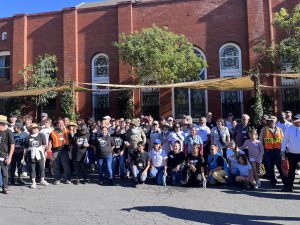Learn More
Voting Rates
Metadata
Variable Definitions:
Voter Registration Rate: The percentage of adults who are registered to vote
Voter Turnout Rate: The percentage of registered voters who cast a ballot in a midterm or general election
Source:
California Statewide Database, General Elections Data
Years Available:
2010, 2012, 2014, 2016, 2018, 2020, 2022
Methodology Note:
Voting Rates are calculated by cross-walking the number of registered voters and the number of votes cast to the census tract level. The voting rate for each census tract, neighborhood, and city is the number of votes cast in that area divided by the number of registered voters in that area.
Registration Rates are calculated by dividing the number of registered voters in each census tract by the number of those aged 18 or older living in the census tract as reported by the American Community Survey (ACS). While the American Community Survey assigns population according to where a respondent self-reports spending the majority of their time, registration numbers do not have the same restriction. Voters may be registered to vote at a different home address than where they count towards the population, such as multiple-property owners or college students. It is also possible for new voters to be registered to vote if they are under 18, as long as they will be 18 by the date of the election. Additionally, voters are not required to re-register for every election and remain on the voting rolls until they provide a change of address or are removed from the voter rolls (for example, due to inactivity).
All of these factors, including the geographic borders of voting precincts not aligning with the geographic borders of census tracts, can create a conflict between the number of registered voters and the adult population in certain communities. Therefore, registration rates calculated to be greater than 100% are assessed on a community-by-community basis, and either top-coded to 100% or denoted as missing if the data is considered to be unreliable for the census tract.
Why are these variables important to measure?
Voting is an important part of political participation and civic engagement in a democracy. In order to be eligible to vote, however, citizens must register to vote. Citizens can register via mail, phone, or at their local election office.
The United States ranks 31st out of the 35 Organization for Economic Cooperation and Development (OECD) countries in voter turnout rates, and California ranks relatively poorly compared to other states within the U.S. A low voter turnout rate in an area could also indicate a need for increased education around voting registration and processes or voter registration campaigns. In an attempt to increase voting rates and citizen participation, California has implemented strategies to make it easier to vote. In fact, voter registration is at 88%, up 15 percentage points from 2015. The California New Motor Voter (CNMV) law may have attributed to this, since it allows the DMV to take information collected for driver’s license and state ID transactions and repurpose it for voter registration.
Voting is an important tool to gauge constituents’ priorities and to include them in the policy-making process. However, voting in the U.S. in unevenly distributed across race and class lines, with white and wealthier Americans voting at much higher rates than low-income people and people of color. This can be particularly consequential in local elections, where higher voter participation from low-income communities of color could have the largest impact on results. Racial inequity issues have been rampant in voting for decades, most notably the voter suppression of black voters. There are also many barriers to access for marginalized folks to keep them from voting. Many workers may face difficulties in voting during their time of work, finding transportation to go vote, and meeting ID requirements that may prevent people from voting. Additionally, many Americans hold permanent residency or green cards, excluding them from being able to engage in this form of civic engagement.
Citation:
Desilver, Drew. “U.S. trails most developed countries in voter turnout.” Pew Research Center, 15 May 2017. Link.
Hajnal, Zoltan L. “Where does America’s low voter turnout matter the most? In local elections.” Washington Post, 24 March 2015. Link.
McDonald, Michael P. “2016 November General Election Turnout Rates.” United States Elections Project, 2016. Link.
McGhee, E., Mehlotra, R. & Romero, M. “Improving California’s Automatic Voter Registration.” Public Policy Institute of California, 2021. Link.
Related Data Stories

The Book Truck: Delivering Literacy in Southern California
Why Do Some People Read? For children in some communities, books and reading are omnipresent. Reading begins as amusement and entertainment and grows into a



